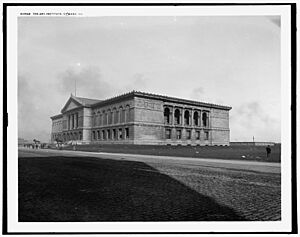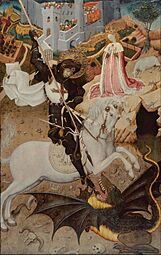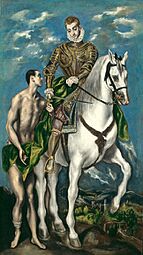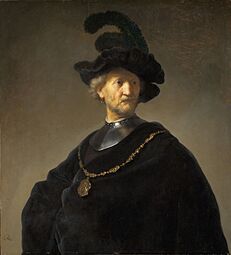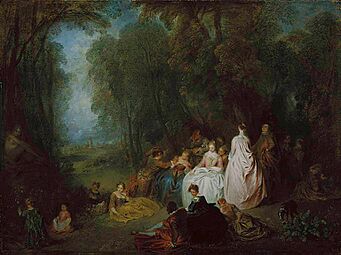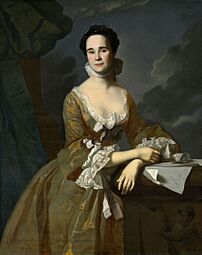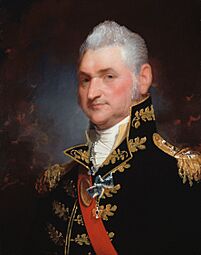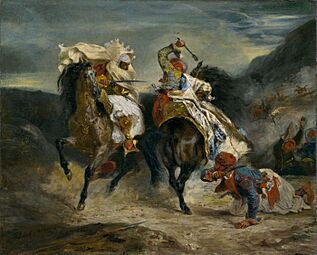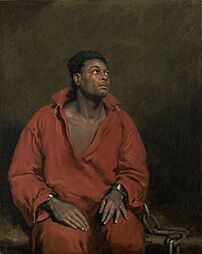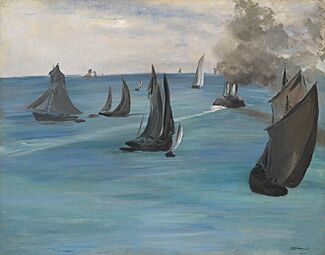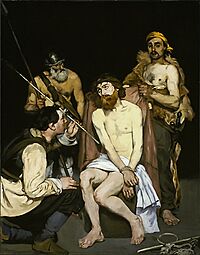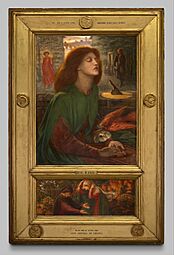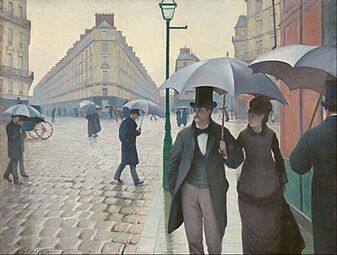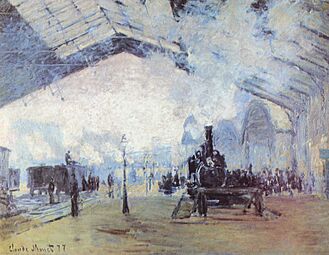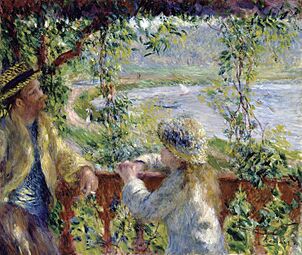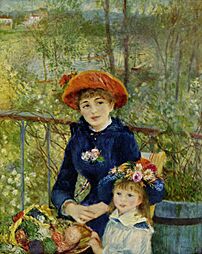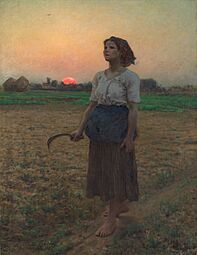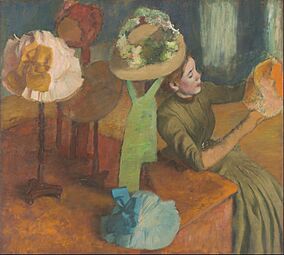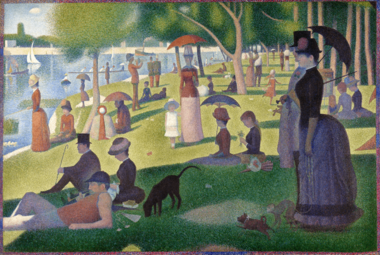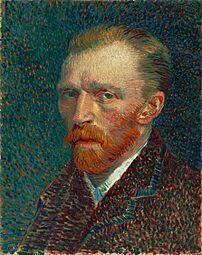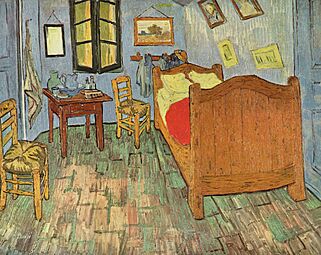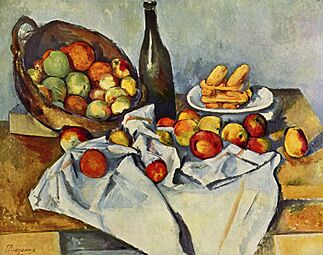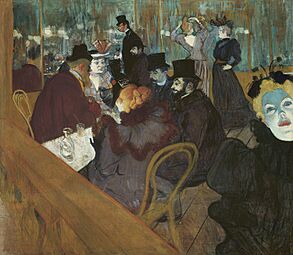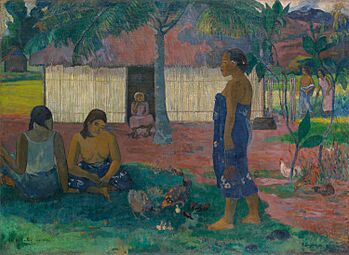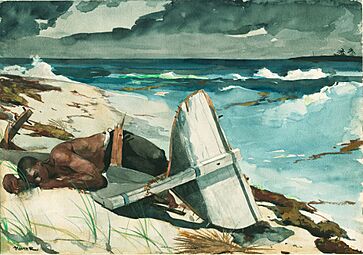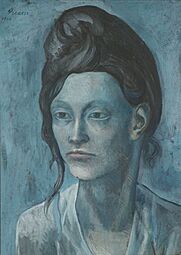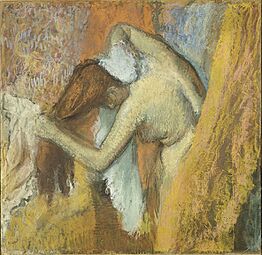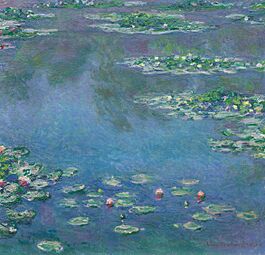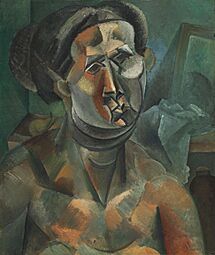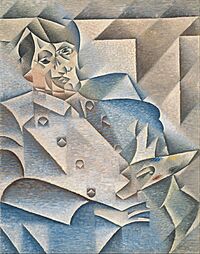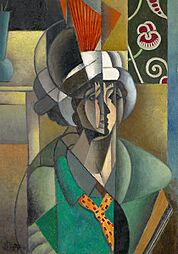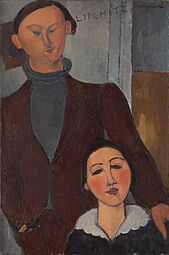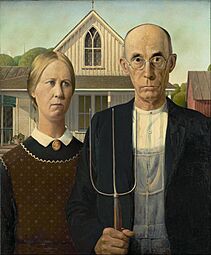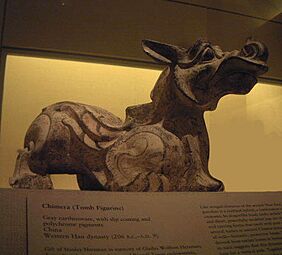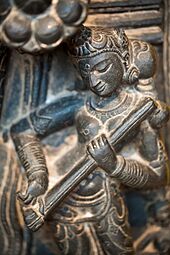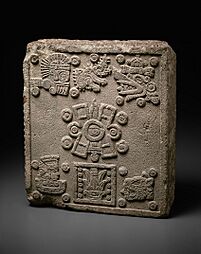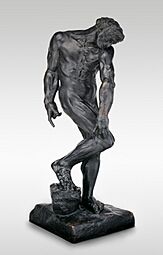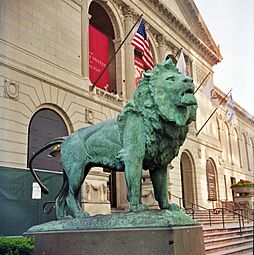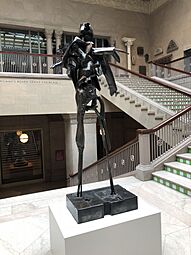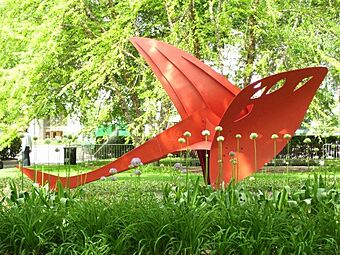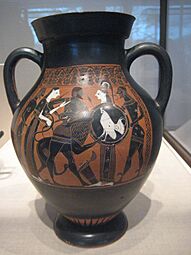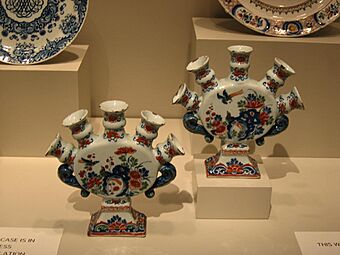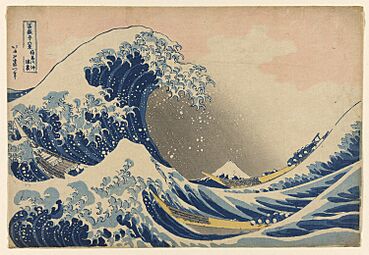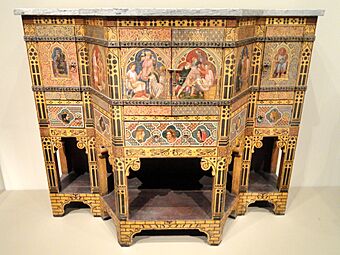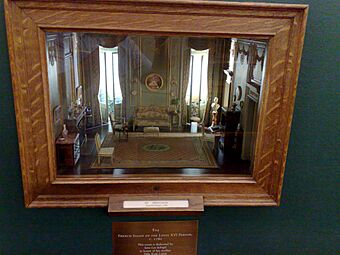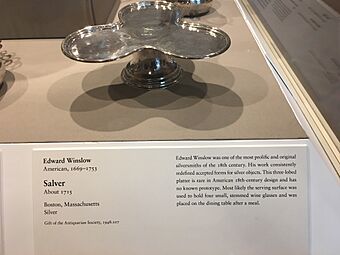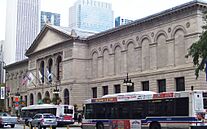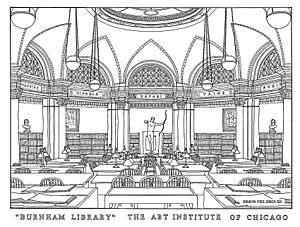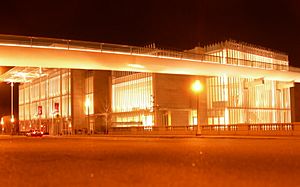Art Institute of Chicago facts for kids
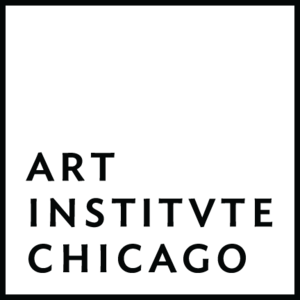 |
|
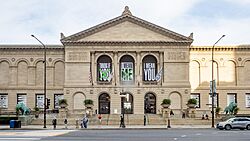
The Art Institute of Chicago seen from Michigan Avenue
|
|
| Established | 1879; in present location since 1893 |
|---|---|
| Location | 111 South Michigan Avenue Chicago, Illinois 60603, U.S. |
| Collection size | 300,000 works |
| Visitors | 1,322,195 (2023) |
| Public transit access | CTA Bus routes: (6 and 28 line) 'L' and Subway stations: Green Brown Orange Pink Purple at Adams/Wabash Red at Monroe/State Blue at Monroe/Dearborn Metra and South Shore Line: ME |
The Art Institute of Chicago is one of the oldest and largest art museums in the United States. It was founded in 1879. The museum is located in Chicago's Grant Park.
The Art Institute has a huge collection of nearly 300,000 artworks. These include famous pieces like Georges Seurat's A Sunday on La Grande Jatte, Pablo Picasso's The Old Guitarist, Edward Hopper's Nighthawks, and Grant Wood's American Gothic. Besides its permanent collection, the museum also hosts over 30 special exhibitions each year.
The Art Institute is also a research center. It has departments for art care and science. It also has the Ryerson and Burnham Libraries, which is one of the biggest art history and architecture libraries in the country.
The museum's main building was built for the 1893 World's Columbian Exposition. Over the years, new parts have been added as the collection grew. The newest part, called the Modern Wing, opened in 2009. It was designed by Renzo Piano. This addition made the Art Institute the second-largest art museum in the U.S.
The Art Institute is connected to the School of the Art Institute of Chicago. This is a top art school. This makes it one of the few places in the U.S. that combines a major art museum with a leading art school.
Contents
History of the Art Institute
How it Started: The 1800s
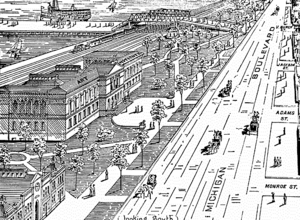
In 1866, 35 artists started the Chicago Academy of Design. They wanted to create a free art school with its own gallery. Classes began in 1868. The academy built a new five-story stone building in 1870.
However, the Great Chicago Fire in 1871 destroyed their building. This left the academy in debt. By 1878, they owed $10,000. Some members left in 1879 to start a new group called the Chicago Academy of Fine Arts. This new group bought the old academy's assets when it went bankrupt.
In 1882, the Chicago Academy of Fine Arts changed its name to the Art Institute of Chicago. Charles L. Hutchinson, a banker, became its first president. He helped turn the Art Institute into a world-class museum. In 1882, the organization bought land on Michigan Avenue. They used an existing building and added new gallery space.
When Chicago was chosen to host the World's Columbian Exposition in 1892–93, the Art Institute wanted a new building for the fair. This building would then become their permanent home. The city agreed. The new building was finished in time for the fair's second year. The Art Institute moved into its new home on October 31, 1893.
Growth in the 1900s
From the early 1900s to the 1960s, the museum offered the Logan Medal of the Arts. This was a very important award for artists in the U.S.
In the 1980s, James N. Wood became the museum's director. He greatly expanded its art collection. He also oversaw a big renovation and expansion of the buildings. Wood organized major art shows that brought record numbers of visitors to the museum.
The Art Institute in the 2000s
In the early 2000s, the museum began building "The Modern Wing." This large addition was designed by Pritzker Prize-winning architect Renzo Piano. It opened on May 16, 2009. The new wing added 264,000 square feet to the museum. This made the Art Institute the second-largest art museum in the United States. The Modern Wing holds the museum's collections of 20th and 21st-century art. This includes modern European paintings, contemporary art, architecture, and photography. In 2014, a travel website named the Art Institute the world's best museum.
In 2015, the museum received a huge gift of art from collectors Stefan Edlis and Gael Neeson. This gift included many important Pop art pieces by artists like Andy Warhol and Roy Lichtenstein. The museum agreed to display these works for at least 50 years. In June 2018, the museum received a $50 million donation. This was the largest single money gift in its history.
In September 2024, the Art Institute announced a $75 million donation from Aaron I. Fleischman and Lin Lougheed. This is the largest naming gift ever for the museum. This money will help create The Aaron I. Fleischman and Lin Lougheed Building. It will show the museum's large collection of late 19th-century, modern, and contemporary art.
In February 2025, Jeffrey and Carol Horvitz gave the Art Institute a huge collection of nearly 2,000 drawings, 200 paintings, and 50 sculptures. These works are by famous French artists like Jacques-Louis David. The collection covers art from the 1500s to the 1800s. The Horvitzes also promised money to help care for and study this collection.
Art Collections at the Museum
The Art Institute of Chicago's collection has over 300,000 artworks. These pieces span more than 5,000 years of human history. They come from cultures all over the world. The museum is especially known for its amazing collection of Western paintings.
African and Native American Art
The museum's African Art and Indian Art of the Americas collections are in two galleries. These are located at the south end of the Michigan Avenue building. The African collection has over 400 works. These include ceramics, clothing, masks, and jewelry from across the continent.
The Native American collection features art from North America, Mesoamerica, and the Andes. It includes pottery and textiles. This collection shows the different styles and themes of art from across the Americas.
American Art
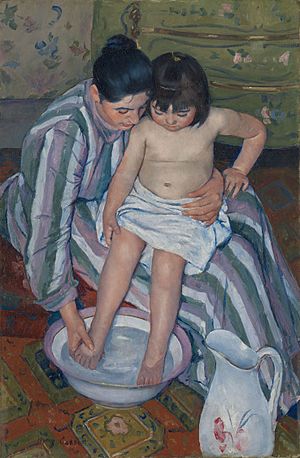
The American Art collection at the Art Institute has some of the most famous American artworks. These include Edward Hopper's Nighthawks, Grant Wood's American Gothic, and Mary Cassatt's The Child's Bath. The collection ranges from old colonial silver to modern paintings.
The museum bought Nighthawks in 1942 for $3,000. This painting is now seen as a symbol of American culture. It is one of Hopper's most famous works. American Gothic has been at the museum since 1930. It shows a serious-looking father and daughter from rural America. The painting won a medal at a contest at the Art Institute in 1930.
Ancient and Byzantine Art
The Art Institute's ancient collection covers almost 4,000 years of art and history. It displays Greek, Etruscan, Roman, and Egyptian sculptures. You can also see mosaics, pottery, jewelry, and ancient coins. There are about 5,000 works in this collection. They show art from the ancient Mediterranean world up to the Byzantine Empire. The collection also has the mummy and mummy case of Paankhenamun.
Architecture and Design
The Architecture and Design Department has over 140,000 works. These include models and drawings from the 1870s to today. The collection covers landscape architecture, structural engineering, and industrial design. It includes works by famous architects like Frank Lloyd Wright and Ludwig Mies van der Rohe.
Asian Art
The Art Institute's Asian collection spans nearly 5,000 years. It includes important works from China, Korea, Japan, India, Southeast Asia, and the Middle East. There are 35,000 objects in this collection. You can see bronzes, ceramics, jade, textiles, and woodcuts. One gallery is designed to feel like a quiet space for viewing Japanese screens.
European Decorative Arts
The European decorative arts collection has about 25,000 objects. These include furniture, ceramics, metalwork, and glass from 1100 AD to today. The department also has the Arthur Rubloff Paperweight Collection with 1,544 objects. Another special part is the 68 Thorne Miniature Rooms. These are tiny rooms, scaled 1:12, showing American, European, and Asian styles from the Middle Ages to the 1930s. Both the paperweights and the Thorne Rooms are on the museum's ground floor.
European Paintings and Sculptures
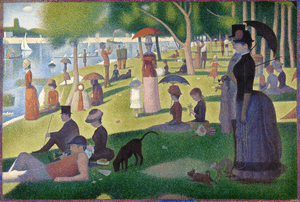
The museum is most famous for its Impressionist and Post-Impressionist paintings. This is one of the best collections outside of France. Highlights include over 30 paintings by Claude Monet, like six of his Haystacks and several Water Lilies. You can also see works by Pierre-Auguste Renoir like Two Sisters (On the Terrace) and Gustave Caillebotte's Paris Street; Rainy Day.
Important Post-Impressionist works include Paul Cézanne's The Basket of Apples. At the Moulin Rouge by Henri de Toulouse-Lautrec is another famous piece. The amazing pointillist painting, Sunday Afternoon on La Grande Jatte—1884 by Georges Seurat, is also a major highlight. It was even featured in the movie Ferris Bueller's Day Off. Other famous paintings include Henri Matisse's Bathers by a River and Vincent van Gogh's Bedroom in Arles.
In the mid-1930s, the Art Institute received over one hundred artworks from Annie Swan Coburn. These "Coburn Renoirs" became the heart of the museum's Impressionist collection. The collection also includes Medieval and Renaissance art, and works by Old Masters.
Modern and Contemporary Art
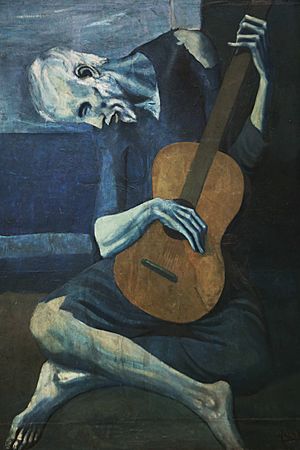
The museum's modern and contemporary art collection grew a lot in 2015. Stefan Edlis and Gael Neeson donated over 40 masterworks. Highlights in the modern galleries include Pablo Picasso's The Old Guitarist, Henri Matisse's Bathers by a River, and René Magritte's Time Transfixed. The contemporary art section has works by Andy Warhol, Cindy Sherman, Jackson Pollock, and other important artists.
Photography
The Art Institute officially started its photography collection in 1949. This happened when Georgia O'Keeffe donated a large part of the Alfred Stieglitz collection. Since then, the museum's collection has grown to about 20,000 works. It covers the history of photography from its start in 1839 to today.
Prints and Drawings
The print and drawings collection began in 1887 with a gift of 460 works. It became its own department in 1911. Now, it has 11,500 drawings and 60,000 prints. These range from 15th-century works to modern ones. The collection includes many works by Albrecht Dürer, Rembrandt van Rijn, and Francisco Goya. Because works on paper are sensitive to light, they are not always on display. This helps keep them in good condition.
Textiles
The Department of Textiles has over 13,000 textiles and 66,000 sample swatches. These come from many cultures, from 300 BC to today. The collection includes English needlework, Japanese clothing, and American quilts. It shows a wide variety of objects, including modern fiber art.
Famous Artworks from the Collection
Many other notable works are in the collection. Here are some examples that are available for public viewing. In 2018, the Art Institute made images of over 52,000 of its public domain works available for free use.
Paintings
-
Martorell, Saint George and the Dragon, around 1434/35
-
El Greco, Saint Martin and the Beggar, around 1597–1600
-
Rembrandt, Old Man with a Gold Chain, around 1631
-
Antoine Watteau, Fête champêtre (Pastoral Gathering), 1718–1721
-
John Singleton Copley, "Mrs. Daniel Hubbard (Mary Greene), 1764
-
Gilbert Stuart, Portrait of Henry Dearborn, 1812
-
Eugène Delacroix, The Combat of the Giaour and Hassan, 1826
-
Édouard Manet, Seascape Calm Weather, 1864–1865
-
Édouard Manet, Jesus Mocked by the Soldiers, 1864–1865
-
Édouard Manet, The Philosopher, (Beggar with Oysters), 1864–1867
-
Dante Gabriel Rossetti, Beata Beatrix, around 1871–1872
-
Gustave Caillebotte, Paris Street; Rainy Day, 1876–1877
-
Claude Monet, Arrival of the Normandy Train, Gare Saint-Lazare, 1877
-
Pierre-Auguste Renoir, By the Water, 1880
-
Pierre-Auguste Renoir, Two Sisters (On the Terrace), 1881
-
Paul Cézanne, The Bay of Marseilles, view from L'Estaque, 1885
-
Edgar Degas, The Millinery Shop, 1885
-
Georges-Pierre Seurat, Sunday Afternoon on the Island of La Grande Jatte 1884–1886
-
Vincent van Gogh, Self-portrait, 1887
-
Vincent van Gogh, Bedroom in Arles, 1888
-
Claude Monet, Wheatstacks (End of Summer), 1890–1891
-
Paul Cézanne, The Basket of Apples, around 1890s
-
Henri de Toulouse-Lautrec, At the Moulin Rouge, 1892
-
Paul Gauguin, Why are you angry? (No te aha oe Riri), 1896
-
Winslow Homer, After the Hurricane, 1899
-
Odilon Redon, Sita, 1903
-
Edgar Degas, Woman at Her Toilette, around 1900–1905
-
Claude Monet, Water Lilies, 1906
-
Pablo Picasso, 1909, Head of a Woman (Tête de femme)
-
Wassily Kandinsky, 1912, Landscape With Two Poplars
-
Kazimir Malevich, Painterly Realism of a Football Player—Color Masses in the 4th Dimension, 1915
-
Amedeo Modigliani, Jacques and Berthe Lipchitz, 1916
-
Grant Wood, American Gothic, 1930
Sculptures
-
A Han dynasty (206 BC – 220 AD), tomb sculpture of a pixiu (or chimera) creature
-
Saraswati playing an alapini vina, Bangladesh, Pala period 10th–12th century AD
-
Aztec, Coronation Stone of Motecuhzoma II (Stone of the Five Suns) 1503
-
Auguste Rodin, Adam (1881) cast in bronze 1924
-
Richard Hunt, Hero Construction, 1958
-
Alexander Calder, Flying Dragon, 1975
More Highlights from the Collection
-
Ancient Greek Amphora depicts Herakles killing the Nemean Lion, with Iolaus and Nemea on the left and Athena and Hermes on the right. 550–525 BC.
-
Illuminated Manuscript page from a Book of Hours, around 1440/45
-
The Great Wave off Kanagawa (Under the Wave off Kanagawa) Japanese woodblock print by Hokusai, around 1830 (this is one of three held by the museum)
-
Sideboard and Wine Cabinet, 1859, designed by William Burges
Museum Architecture
The current museum building at 111 South Michigan Avenue is the third home for the Art Institute. It is in Grant Park. The building was designed in the Beaux-Arts style. It was built to host meetings for the 1893 World's Columbian Exposition. The plan was for the Art Institute to use the building after the fair ended.
The main entrance on Michigan Avenue is guarded by two bronze lion statues. These lions were revealed on May 10, 1894. Each one weighs over two tons. The sculptor, Edward Kemeys, gave them unofficial names. The south lion "stands in an attitude of defiance," and the north lion is "on the prowl." When Chicago sports teams play in championships, the lions sometimes wear their team uniforms. During Christmas, they wear evergreen wreaths around their necks.
The east entrance of the museum has a stone arch from the old Chicago Stock Exchange. This arch was designed by Louis Sullivan in 1894. The Exchange building was torn down in 1972. But parts of its trading room were saved and rebuilt at the Art Institute.
The Art Institute building is unique because it sits over open-air railroad tracks. Two floors of galleries connect the east and west parts of the building. The Metra Electric and South Shore trains run underneath. The lower gallery level used to be a windowless hall. Now, it is the Alsdorf Galleries, showing Indian, Southeast Asian, and Himalayan art. During renovations, windows facing Millennium Park were added.
In September 2024, the museum announced a $75 million gift for a new gallery building or wing. It will be named after Aaron I. Fleischman and Lin Lougheed. This new space will show more 19th-century, modern, and contemporary art. The design and location of this new gallery are still being decided.
Museum Libraries
The Ryerson & Burnham Libraries are located on the ground floor of the museum. These libraries have collections covering all periods of art. They are especially known for their large collection of 18th to 20th-century architecture books. The libraries serve museum staff, students, and are also open to the public.
The Modern Wing
The Art Institute opened the Modern Wing on May 16, 2009. This was the biggest expansion in the museum's history. The 264,000-square-foot addition was designed by Renzo Piano. It made the Art Institute the second-largest museum in the U.S.
The Modern Wing is home to the museum's collection of early 20th-century European art. This includes Pablo Picasso's The Old Guitarist and René Magritte's Time Transfixed. It also has a large public display of Joseph Cornell's unique box artworks. The wing also features contemporary art from after 1960. There are new galleries for photography, video, architecture, and design. You can see original drawings by Frank Lloyd Wright here. The Modern Wing also has temporary exhibition spaces, shops, classrooms, and a cafe. A special bridge, the Nichols Bridgeway, connects the roof of the new wing to Millennium Park nearby.
Museum Leadership and Visitors
Museum Directors
- William M. R. French (1885–1914)
- Newton Carpenter (1914–1916)
- George Eggers (1918–1921)
- Robert Harshe (1921–1938)
- Daniel Catton Rich (1938–1958)
- Allen McNab (1956–1965)
- Charles Cunningham (1965–1972)
- E. Laurence Chalmers (1972–1986)
- James N. Wood (1980–2004)
- James Cuno (2004–2011)
- Douglas Druick (2011–2016)
- James Rondeau (2016–present)
Visitor Numbers
In 2009, about 2 million people visited the Art Institute. This was a 33 percent increase from 2008. The new Modern Wing helped bring in many more visitors. In 2022, the museum welcomed 1.04 million visitors. This was an increase from 2021. The Art Institute was the tenth most-visited museum in the United States that year. It was also the sixth most-visited U.S. art museum.
Art Acquisitions and Returns
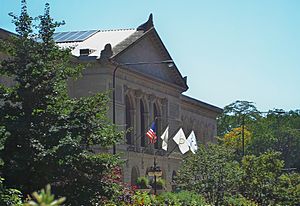
The Art Institute has a special department that researches where artworks came from. This is called the Provenance Research Department. It was officially started in 2020. This team checks the history of all artworks in the collection. They also research new art the museum wants to buy or borrow.
Returning Art to its Home
In June 2024, the Art Institute of Chicago returned a 12th-century stone carving to Thailand. This artwork showed the Hindu god Krishna. It was originally thought to be from Cambodia. But research showed it came from the Phanom Rung temple in northeastern Thailand. After talking with Thai officials, the museum sent the piece back.
On March 3, 2025, the Art Institute announced another return. They sent a 12th-century Nepali sculpture back to Nepal. This sculpture, Buddha Sheltered by the Serpent King Muchalinda, was confirmed to have been stolen from a temple in the Kathmandu Valley. The sculpture had been on display at the museum since 1997.
See also
 In Spanish: Instituto de Arte de Chicago para niños
In Spanish: Instituto de Arte de Chicago para niños
- American Academy of Art College
- List of largest art museums
- List of most-visited museums in the United States
- List of museums and cultural institutions in Chicago
- Visual arts of Chicago
- Lions (Kemeys)


